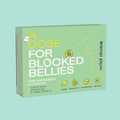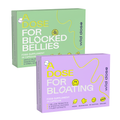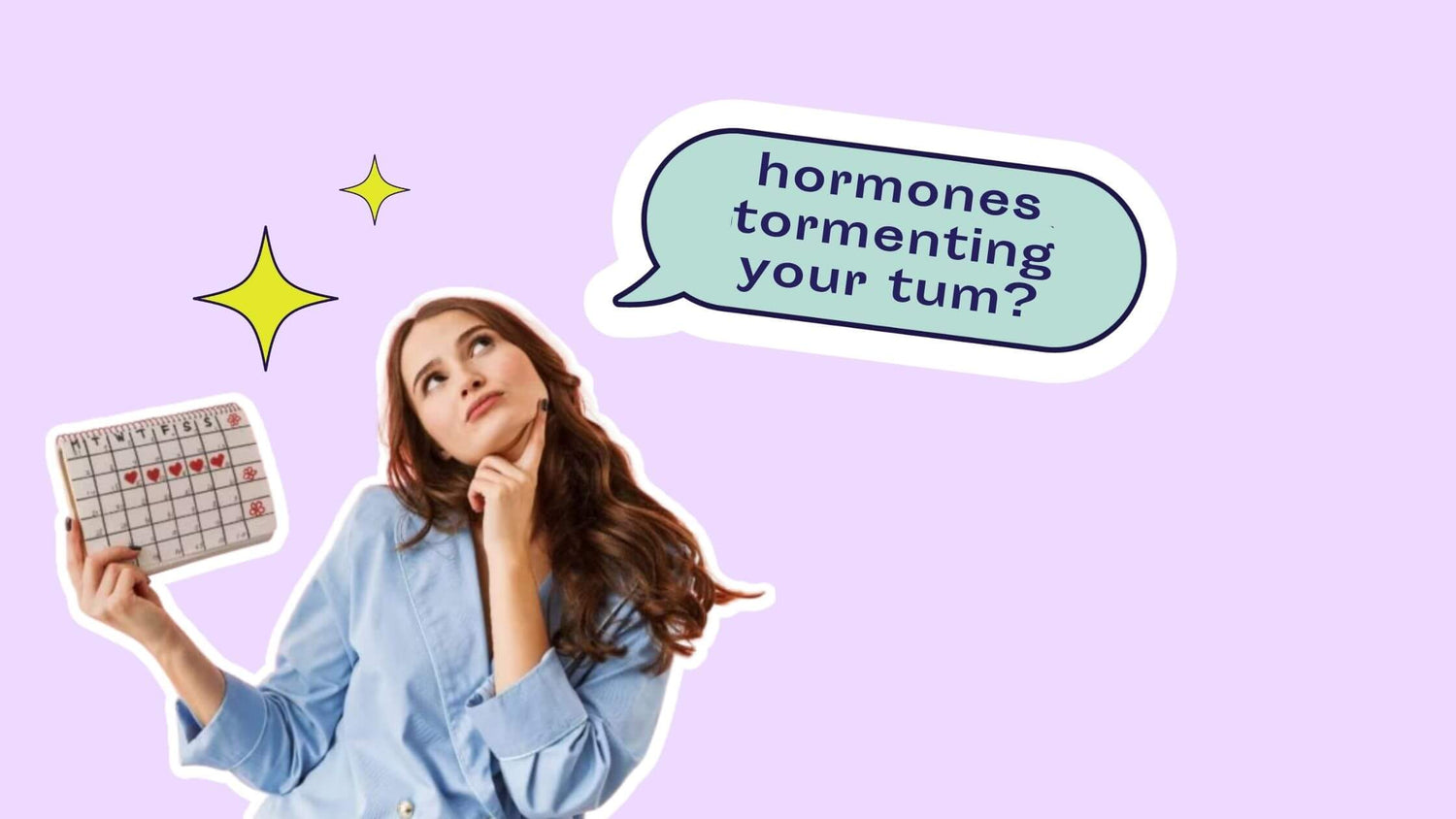How Do the Different Stages of My Cycle Affect My Gut?
The menstrual cycle has three distinct phases - the follicular, luteal, and menstrual cycles. You might also hear people talking about the ovulatory phase, which refers to when you release an egg (ovulation).
As a woman, your reproductive cycle is a vital sign, and the health of your cycle is a key indicator of your overall health and well-being. If you have an irregular or absent cycle, severe PMS, or a short luteal phase, it’s likely that you have some underlying hormonal imbalances.
Your menstrual cycle can impact every other part of your body because the hormone that regulates the menstrual cycle are reeeeeally important and can affect many other things besides your periods.
For example, oestrogen’s role in the menstrual cycle is to help thicken the uterine lining, be ready for potential implantation, and stimulate a surge of LH, which leads to ovulation. However, oestrogen’s roles extend far beyond this. It’s been shown to play a role in serotonin production, mood regulation, cardiovascular health, and brain health (fascinating, right?!).
Oestrogen also impacts your gut, as do some of the other reproductive hormones, such as progesterone. But how do they influence your gut health? How is your gut affected at each stage of your reproductive cycle?
Let’s dive into the different stages of the menstrual cycle and how these stages impact gut health. I’ll finish off by giving you my top tips for reducing bloating quickly at every stage of your menstrual cycle.
What Are the Stages of My Cycle?
To fully understand how your menstrual cycle affects your gut and causes bloating, you first need to know the basics of your cycle.
The menstrual cycle refers to the monthly process that a woman goes through, during which she grows and matures an egg, builds a uterine lining, releases the matured egg into the fallopian tube, and sheds the uterine lining if the egg does not get fertilised. This process continues in a cycle if you’re not pregnant.
If the egg is fertilised by a sperm cell, the uterine lining won’t shed. The fertilised egg (now an embryo) will implant into the lining, where it continues to grow into a foetus and a healthy baby.
I mentioned above that there are three main stages of the menstrual cycle, and I’m going to cover these cycle stages in more detail now.
1. The menstrual phase
Menstruation refers to the stage in your cycle where you’re bleeding. During this phase, your endometrial lining (uterine lining) sheds in response to contractions of the myometrium (uterine smooth muscle). It’s these contractions that cause the dreaded period cramps!
The first day you start bleeding is day one of your cycle. Menstruation is caused by the rapid drop in progesterone.
During the luteal phase, the corpus luteum (the gland that your body makes from the broken down, unfertilised egg - yes, your body makes a whole new gland every month!) secretes progesterone. After between 12-14 days, it starts to break down, and the resulting drop in progesterone signals to your body that you’re not pregnant and it’s time to shed the uterine lining that it has built over the last month.
A healthy period should last between three and five days. However, you might have a seven-day period if you have a couple of days of spotting on either side of your heavier days of flow. And believe it or not, you only lose about 2-3 tablespoons of blood during your period (even though it seems like gallons)!
2. The follicular phase
The follicular phase is the phase of your cycle that spans from menstruation to ovulation. Generally, the follicular lasts between 10 and 20 days, and it’s during this phase that your hypothalamus is telling your pituitary to make follicle-stimulating hormone (FSH).
FSH causes the eggs in your ovaries to mature. When one egg is mature enough, it is released at ovulation in response to a bit surge in luteinising hormone (LH). During this phase, oestrogen is also at work, thickening the uterine lining in case there is an embryo that wants to implant after ovulation.
The egg sits there for just 12 to 24 hours, waiting for sperm to race towards it. If it’s fertilised, it will grow into an embryo, implant into the uterus lining, and you’ll become pregnant. If it’s not fertilised, it will break down into the corpus luteum.
3. The luteal phase
When the corpus luteum forms, it starts to produce progesterone in response to mini pulses of LH from the brain. This begins the luteal phase of your menstrual cycle that lasts from ovulation to your next period.
During this phase, progesterone is high, and it can cause a bunch of symptoms, like tender breasts, fatigue, and headaches. That’s why many women feel like they want to chill out a lot more during this phase of their cycles.
How Does Each Stage of My Cycle Impact My Gut?
The menstrual cycle is primarily for reproduction. However, the hormonal fluctuations that occur throughout the cycle can also have an impact on the gut.
Below, I’ve covered how each stage of your menstrual cycle affects your gut.
1. Your gut health in the menstrual phase
During this stage, the uterus sheds its lining, resulting in menstrual bleeding.
Most women experience bloating due to increasing water retention. The prostaglandins that your body produces during this phase cause the uterine muscle to contract in order to shed the lining (which can be painful). These pesky prostaglandins also affect the smooth muscle in your gut, causing digestion to slow down and leading to symptoms like cramping and diarrhoea.
2. Your gut health in the follicular phase
Gut function is relatively stable during this phase of the menstrual cycle. However, you might find that you start to experience changes in bowel movements or appetite as you approach ovulation due to hormonal fluctuations.
You might have some abdominal pains or light cramps around ovulation due to the cyst that’s holding the mature egg rupturing to release the egg. However, these cramps and digestive symptoms should be relatively mild and short-lived.
3. Your gut health in the luteal phase
Once you’ve ovulated, your progesterone levels start to rise. Progesterone can slow down gut motility, leading to symptoms such as bloating and constipation.
Increased progesterone levels can also influence the composition of your gut microbiome. The exact way that this work is unknown, and we need more studies to confirm this.
How Can I Avoid Bloating At Each Stage of My Menstrual Cycle?
Bloating is a common symptom that many women experience during their menstrual cycle. For some, bloating is only mild and isn’t accompanied by other digestive symptoms. Other women experience severe bloating daily, alongside other symptoms like abdominal cramps.
Here are some helpful remedies to tackle bloating at each of the three cycle stages.
1. Bloating remedies for the menstrual phase
Hormonal bloating tends to be at its worst during menstruation and the luteal phase that precedes it. If you’re prone to bloating when on your period, try the following remedies:
- Stay hydrated - dehydration can exacerbate bloating, so make sure to drink plenty of water throughout the day.
- Reduce your salt intake - sodium can increase water retention in the gut, making bloating worse. Limit your intake of sodium-rich foods like ready meals, pre-packaged foods, takeaways, and salty snacks.
- Eat smaller, more frequent meals - eating less volume of food in one sitting will make it easier for your digestive system to metabolise and absorb all the food.
2. Reducing bloating in the follicular phase
Although bloating tends to be at its mildest during the first phase of your cycle, you might still have some slight bloating at times. This will most likely be due to the types and volume of foods that you’re eating, so it’s best to eat smaller meals more frequently to minimise bloat.
If you know that certain foods cause bloating to get worse for you, then it’s a good idea to choose alternatives (this applies to any stage of your cycle). Again, make sure to stay hydrated and limit sodium intake.
3. How to keep bloating at bay during your luteal phase
As bloating is usually at its most severe during the second half of your cycle (and usually worsens as you approach your period), you might need to do several things to keep bloating at bay.
Here are some helpful lifestyle changes to reduce bloating as you go through your luteal phase:
- Limit caffeine and alcohol intake - both caffeinated and alcoholic drinks can worsen bloating by causing you to become dehydrated. Limit your intake of these beverages (ideally no more than 200 mg of caffeine a day (around two medium coffees)) and make sure to drink plenty of water in between.
- Choose anti-inflammatory foods - reducing inflammation can support your digestion during the luteal phase of your cycle, so choose things like berries, avocados, oily fish, and cocoa-based products.
- Increase your fibre intake - fibre can help to soften the stool and reduce the risk of bloating and constipation. Fibre-rich foods include fruits, vegetables, and whole grains.
- Reduce your intake of gassy foods and drinks - gas-producing foods and drinks include cruciferous vegetables, lentils, beans, fruit juice, energy drinks, and fizzy sodas.
- Avoid high-intensity exercise - gentle exercise is best for supporting digestion and reducing bloating in your luteal phase. Choose yoga, walking, or low-intensity swimming.
- Drink herbal teas - if you enjoy the taste of herbal teas, consuming them in the luteal phase can be great for supporting your natural digestive processes. Go for chamomile, peppermint, ginger, or turmeric tea.
Say No to the Bloat with Probiotics
I’ve not yet mentioned the benefits of using probiotics as a bloating remedy. I wanted to make a section dedicated solely to this, as probiotics can be useful at every one of the cycle stages.
Probiotics are live bacteria that are known to be beneficial for digestion (and overall health, for that matter). They include species such as Lactobacillus, Bifidobacterium, Enterococcus, and Streptococcus.
Probiotic bacteria reside naturally in their millions in your colon (you’re more bacteria than you are human!), and they help your body to break down food for absorption into the bloodstream. They also play a vital role in immunity and the production of helpful compounds, such as vitamins and short-chain fatty acids. They feed off fibres known as prebiotics, which are present in fruits, vegetables, and whole grains.
The use of probiotics for a range of health conditions, including digestive issues, is well-established. For example, probiotic supplements have been shown to be beneficial for irritable bowel syndrome (IBS), inflammatory bowel disease (IBD), atopic dermatitis (a type of eczema that causes skin inflammation and redness), hypercholesterolaemia (high blood cholesterol), and even obesity.
You can find probiotic bacteria in a range of fermented foods and drinks, including sourdough bread, yoghurt, tofu, tempeh, sauerkraut, miso, kimchi, natto, apple cider vinegar, and kombucha. However, if you don’t eat many of these foods, you can take a probiotic supplement to support the beneficial bugs that are already in your gut.
At Wild Dose, we’ve got the perfect probiotic supplement to tackle bloating at all stages of your menstrual cycle. A Dose For Bloating contains two billion probiotic bacteria, seven digestive enzymes, and seven plant extracts to support your digestion and provide gas relief









